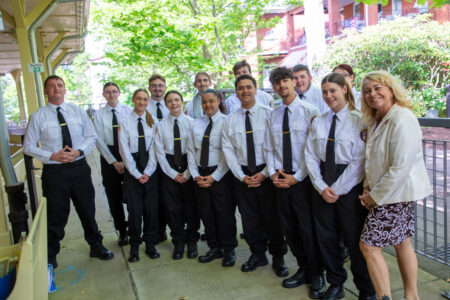Another Look At The Remarkable Life Of Catherine Harris
Some readers may be familiar with Catherine Harris and the story of her life. She has been the subject of many articles and many stories. A brief outline of her life is as follows. Taken from the many writings about her over the years, we have this information.
She was born in the Meadville, Pa., area in 1809 and died in Jamestown in 1907. One account says she married John Harris in Erie, Pa., and they moved here in 1831. But other accounts indicate that she and her infant daughter arrived in Jamestown in 1831 after her husband had died in Buffalo, or in Erie. Her husband’s name has been stated as Britton, and as Butler. She married John Harris probably about 1835. He first announces the location of his barber shop in Jamestown in the 1834 Jamestown Journal. His family had been in the area before this time but was not living in Jamestown. Catherine is credited with being the first African-American resident in the Village of Jamestown. Her daughter was Mariah, sometimes referred to as Maria.
John and Catherine lived at what became 12 W. Seventh St. Catherine was very involved for many years with the Underground Railroad in Jamestown. Catherine had a colorful flower garden at her home and was also known for her nursing skills. She was a washerwoman, a nurse, and a cook for many of the Jamestown families through the years. We know that John was a barber beginning in 1834. The newspaper carried an advertisement in 1844 that Anthony Harris took over John Harris’s former location of the barber shop. At the same time period, John announced his new location for his barber shop.
Despite what has been written about Catherine and her family, there are still gaps in the information that bring up questions. Some of the questions may never be answered or answered with certainty. Some of the questions include the following. It is more often said that she and her infant daughter were the first African-American residents in Jamestown. So that statement seems to indicate that she did not come here with a husband in the person of John Harris. John Harris appears in Jamestown by 1834, maybe earlier but we have no proof of his residency before 1834. When did they get married? So far no record has come to light to indicate a date. Nor is there any record to support a claim that John died in 1852. And a big question is why did Catherine come to Jamestown?
When Catherine and Mariah arrived in Jamestown in 1831, where did they live? Most of Jamestown existed south of what is now Fourth Street so it is unlikely that there was a house at what became 12 W. Seventh St. in 1831. It is unlikely that Catherine built her house in 1831 on West Seventh Street. The property at the corner of West Seventh Street and North Main Street was purchased by John Harris in 1838 with the deed recorded in 1844. The land was purchased from Henry Baker. John and Catherine had a mortgage on the property in 1845 but there is no record found yet, of it being paid or of it going into foreclosure. If John died in 1852, did the property go to Catherine? If so, why did she receive a deed to the same property in 1859 from Madison Burnell? Did she live in the different houses on the property or did the numbering of the houses on the street change, and if so, when? She lived at No. 4 West Seventh Street and at No. 12 West Seventh Street. A careful study of addresses and maps of the property, plus the deeds, over the decades may answer that question or may complicate it ever further.
Catherine sold pieces of the property at different times and even bought a piece of it back at one point. Maps show more than one structure on that property over the years. She bought additional property adjoining the original parcel. Her great-grand son lived there even after Catherine’s death. Did he inherit the property or was it sold to him at some point “for a dollar and love and affection” as was often done with family members. More searching in the deeds may reveal that.
These are a few of the questions that need answers to fill in gaps in the lives of Catherine, John, and Mariah. Over time, research may answer some questions and bring to life a remarkable woman who lived through so much of Jamestown’s history. She saw the change from Village to City, witnessed the ending of slavery in the United States, and the advent of the horseless carriage and the airplane, and so much more.






